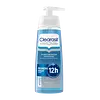What's inside
What's inside
 Key Ingredients
Key Ingredients

 Benefits
Benefits

 Concerns
Concerns

 Ingredients Side-by-side
Ingredients Side-by-side

Water
Skin ConditioningGlycerin
HumectantSodium Laureth Sulfate
CleansingCoco-Glucoside
CleansingCocamidopropyl Betaine
CleansingSalicylic Acid
MaskingPEG-200 Hydrogenated Glyceryl Palmate
CleansingSodium Chloride
MaskingLaureth-4
EmulsifyingPEG-7 Glyceryl Cocoate
EmulsifyingPolyquaternium-43
Parfum
MaskingLavandula Stoechas Extract
MaskingHelichrysum Italicum Extract
AntiseborrhoeicCistus Monspeliensis Extract
MaskingSodium Hydroxide
BufferingPhenoxyethanol
PreservativeSodium Benzoate
MaskingCI 42090
Cosmetic ColorantWater, Glycerin, Sodium Laureth Sulfate, Coco-Glucoside, Cocamidopropyl Betaine, Salicylic Acid, PEG-200 Hydrogenated Glyceryl Palmate, Sodium Chloride, Laureth-4, PEG-7 Glyceryl Cocoate, Polyquaternium-43, Parfum, Lavandula Stoechas Extract, Helichrysum Italicum Extract, Cistus Monspeliensis Extract, Sodium Hydroxide, Phenoxyethanol, Sodium Benzoate, CI 42090
Salicylic Acid 2%
MaskingWater
Skin ConditioningSodium Laureth Sulfate
CleansingDecyl Glucoside
CleansingGlycerin
HumectantSodium Chloride
MaskingCoco-Betaine
CleansingPEG-150 Pentaerythrityl Tetrastearate
EmulsifyingHexylene Glycol
EmulsifyingSodium Hydroxide
BufferingPEG-6 Caprylic/Capric Glycerides
EmulsifyingZinc Gluconate
Skin ConditioningTetrasodium EDTA
Polyquaternium-47
Skin ConditioningMenthol
MaskingCapryloyl Salicylic Acid
ExfoliatingCitric Acid
BufferingSalicylic Acid 2%, Water, Sodium Laureth Sulfate, Decyl Glucoside, Glycerin, Sodium Chloride, Coco-Betaine, PEG-150 Pentaerythrityl Tetrastearate, Hexylene Glycol, Sodium Hydroxide, PEG-6 Caprylic/Capric Glycerides, Zinc Gluconate, Tetrasodium EDTA, Polyquaternium-47, Menthol, Capryloyl Salicylic Acid, Citric Acid
 Reviews
Reviews

Ingredients Explained
These ingredients are found in both products.
Ingredients higher up in an ingredient list are typically present in a larger amount.
Glycerin is already naturally found in your skin. It helps moisturize and protect your skin.
A study from 2016 found glycerin to be more effective as a humectant than AHAs and hyaluronic acid.
As a humectant, it helps the skin stay hydrated by pulling moisture to your skin. The low molecular weight of glycerin allows it to pull moisture into the deeper layers of your skin.
Hydrated skin improves your skin barrier; Your skin barrier helps protect against irritants and bacteria.
Glycerin has also been found to have antimicrobial and antiviral properties. Due to these properties, glycerin is often used in wound and burn treatments.
In cosmetics, glycerin is usually derived from plants such as soybean or palm. However, it can also be sourced from animals, such as tallow or animal fat.
This ingredient is organic, colorless, odorless, and non-toxic.
Glycerin is the name for this ingredient in American English. British English uses Glycerol/Glycerine.
Learn more about GlycerinSalicylic Acid (also known as beta hydroxy acid or BHA) is a well-known ingredient for treating skin that struggles with acne and clogged pores. It exfoliates both the skin's surface and deep within the pores to help clear out buildup, control oil, and reduce inflammation.
Unlike AHAs (alpha hydroxy acids), salicylic acid is oil-soluble. This allows it to penetrate into pores which makes it especially effective for treating blackheads and preventing future breakouts.
Salicylic acid is also known for its soothing properties. It has a similar structure to aspirin and can calm inflamed or irritated skin, making it a good option for acne-prone skin that is also sensitive.
Concentrations of 0.5-2% are recognized by the U.S. FDA as an over-the-counter topical acne product.
It can cause irritation and/or dryness if one's skin already has a compromised moisture barrier, so it's best to focus on repairing that before introducing this ingredient into your routine.
While salicylic acid does not increase sun sensitivity, it’s still important to wear sunscreen daily to protect your skin.
If you are looking for the ingredient called BHA or Butylated Hydroxyanisole, click here.
Learn more about Salicylic AcidChances are, you eat sodium chloride every day. Sodium Chloride is also known as table salt.
This ingredient has many purposes in skincare: thickener, emulsifier, and exfoliator.
You'll most likely find this ingredient in cleansers where it is used to create a gel-like texture. As an emulsifier, it also prevents ingredients from separating.
There is much debate on whether this ingredient is comedogenic. The short answer - comedogenic ratings don't tell the whole story. Learn more about comegodenic ratings here.
The concensus about this ingredient causing acne seems to be divided. Research is needed to understand if this ingredient does cause acne.
Scrubs may use salt as the primary exfoliating ingredient.
Learn more about Sodium ChlorideSodium Hydroxide is also known as lye or caustic soda. It is used to adjust the pH of products; many ingredients require a specific pH to be effective.
In small amounts, sodium hydroxide is considered safe to use. However, large amounts may cause chemical burns due to its high alkaline.
Your skin has a natural pH and acid mantle. This acid mantle helps prevent harmful bacteria from breaking through. The acid mantle also helps keep your skin hydrated.
"Alkaline" refers to a high pH level. A low pH level would be considered acidic.
Learn more about Sodium HydroxideSodium Laureth Sulfate (SLES) is a foaming, cleansing, and emulsifying ingredient. It is created from palm kernel oil or coconut oil. SLES is not the same as sodium lauryl sulfate. It is much milder and less likely to irritate.
SLES helps create foam in personal products. It also prevents ingredients from separating, helping to elongate the shelf life.
Sodium Laureth Sulfate is a type of sulfate. It can be drying. We recommend speaking with a professional about using this ingredient if you have concerns.
Learn more about Sodium Laureth SulfateWater. It's the most common cosmetic ingredient of all. You'll usually see it at the top of ingredient lists, meaning that it makes up the largest part of the product.
So why is it so popular? Water most often acts as a solvent - this means that it helps dissolve other ingredients into the formulation.
You'll also recognize water as that liquid we all need to stay alive. If you see this, drink a glass of water. Stay hydrated!
Learn more about Water